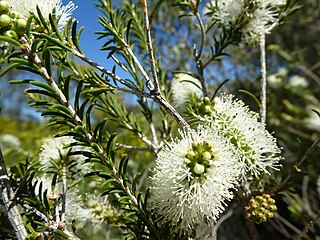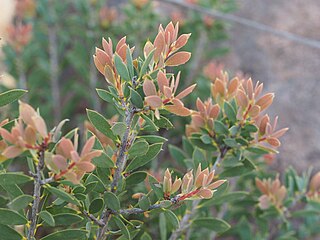
Melaleuca quinquenervia, commonly known as the broad-leaved paperbark, paper bark tea tree, punk tree or niaouli, is a small- to medium-sized tree of the myrtle family, Myrtaceae. It grows as a spreading tree up to 20 m (70 ft) tall, with its trunk covered by a white, beige and grey thick papery bark. The grey-green leaves are egg-shaped, and cream or white bottlebrush-like flowers appear from late spring to autumn. It was first formally described in 1797 by the Spanish naturalist Antonio José Cavanilles.

Melaleuca linariifolia is a plant in the myrtle family Myrtaceae, and is endemic to eastern Australia. It is commonly known as snow-in-summer, narrow-leaved paperbark, flax-leaved paperbark and in the language of the Gadigal people as budjur. A hardy plant, it flowers prolifically in late spring or summer, making it a popular garden shrub or small tree in temperate places. Melaleuca trichostachya is a similar species but its leaves are arranged differently and the fruits have projecting valves.

Melaleuca preissiana, commonly known as stout paperbark, modong or moonah, is a plant in the myrtle family, Myrtaceae and is endemic to coastal areas of southwest Australia. It is a shrub or small tree with papery bark, small leaves and spikes of usually white flowers. It occurs chiefly in areas that are seasonally wet.

Melaleuca leucadendra, commonly known as weeping paperbark, long-leaved paperbark or white paperbark is a plant in the myrtle family, Myrtaceae and is widespread in northern Australia, Southeast Asia, New Guinea and the Torres Strait Islands. It is a tree, sometimes growing to more than 20 m (70 ft) with a trunk covered with thick, white, papery bark and weeping thinner branches. It has a long flowering season, can flower at almost any time of the year and is often grown as a tree in parks and on roadsides. It was the first melaleuca to be described and was described from a specimen growing in Indonesia.

Melaleuca rhaphiophylla, commonly known as swamp paperbark is a plant in the myrtle family, Myrtaceae and is endemic to the south west of Western Australia. It has narrow, needle-like leaves and profuse spikes of white or yellowish flowers at variable times throughout the year. As its common name suggests, it is usually found in salt marshes, or swamps or along watercourses and occurs over wide areas of the south-west.

Melaleuca lanceolata commonly known as black paperbark, moonah, Rottnest Island teatree and western black tea tree is a plant in the myrtle family, Myrtaceae and is native to Australia where it occurs in Western Australia, South Australia, Victoria, New South Wales and Queensland. It is a densely foliaged tree with rough bark, which flowers prolifically in summer.

Melaleuca viridiflora, commonly known as broad-leaved paperbark, is a plant in the myrtle family Myrtaceae, and is native to woodlands, swamps and streams in monsoonal areas of northern Australia and New Guinea. It is usually a small tree with an open canopy, papery bark and spikes of cream, yellow, green or red flowers.

Eucalyptus longifolia, commonly known as woollybutt, is a species of medium-sized tree that is endemic to eastern Australia. It has thick, fibrous bark on the trunk and larger branches, lance-shaped to curved adult leaves, flower buds in groups of three, white flowers and cup-shaped to cylindrical or hemispherical fruit. The drooping flower heads in groups of three are a distinguishing feature. It grows in heavy soils often near water.

Melaleuca trichostachya is a plant in the myrtle family, Myrtaceae and is native to inland northern New South Wales, Queensland, South Australia and the Northern Territory in Australia. It is a small tree, similar to the commonly cultivated Melaleuca styphelioides, with its prickly foliage and fluffy spikes of white or cream flowers but there are differences in the leaf arrangement and fruiting capsules.

Melaleuca ericifolia, commonly known as swamp paperbark, is a plant in the myrtle family, Myrtaceae and the genus Melaleuca, native to south-eastern Australia. It is a rather variable species and some specimens resemble Melaleuca armillaris but its papery bark and smaller, more prolific flower heads distinguish it from that species. It often grows in swampy areas and the draining and clearing of these has reduced the numbers of the species, especially around Port Philip Bay near Melbourne. It is also similar to Melaleuca pustulata, a Tasmanian endemic, but that species only grows in dry heath.

Melaleuca squamophloia is a plant in the myrtle family, Myrtaceae and is endemic to the black soil plains of south eastern Queensland in Australia. Like its close relative Melaleuca styphelioides, it is a small, erect tree with prickly leaves and spikes of cream or white flowers but its bark is hard rather than papery and the leaves have fewer veins than that species.

Eucalyptus eugenioides, commonly known as the thin-leaved stringybark or white stringybark, is a species of tree endemic to eastern Australia. It is a small to medium-sized tree with rough stringy bark, lance-shaped to curved adult leaves, Flower buds in groups of between nine and fifteen, white flowers and hemispherical fruit.

Amyema congener, commonly known as the variable mistletoe, is a species of flowering plant, an epiphytic hemiparasitic plant of the family Loranthaceae from eastern Australia. It is found on members of the genera Allocasuarina, Acacia and some exotic species.

Melaleuca nodosa, commonly known as the prickly-leaved paperbark, is a plant in the myrtle family Myrtaceae, and is endemic to eastern Australia. It is a shrub or small tree with narrow, sometimes needle-like leaves and profuse heads of yellow flowers as early as April or as late as January.

Melaleuca dealbata, commonly known as karnbor or blue paperbark, is a plant in the myrtle family, Myrtaceae and is native to tropical areas in northern Australia, New Guinea and Indonesia. It is a medium to large leafy tree, growing in wet areas such as on the edges of coastal lagoons. It has papery bark, relatively large, blue-green leaves and spikes of cream-coloured flowers over a long period.

Melaleuca deanei, commonly known as Deane's paperbark, is a plant in the myrtle family, Myrtaceae and is endemic to New South Wales in Australia. It is a shrub with flaky bark, narrow oval leaves and spikes of white flowers in spring and summer. The species only exists in a few isolated populations and is classified as vulnerable.

Melaleuca diosmatifolia, commonly known as rosy paperbark and pink honey-myrtle is a plant in the myrtle family, Myrtaceae and is native to Queensland and New South Wales in Australia. It was formerly known as Melaleuca erubescens but is not closely related to Melaleuca diosmifolia although the species name has the same meaning. It has pointed, non-prickly leaves and cylindrical spikes of pink or purple flowers.

Melaleuca groveana, commonly known as Grove's paperbark is a plant in the myrtle family Myrtaceae and is endemic to New South Wales and Queensland in Australia. It is an uncommon species with relatively large heads of white flowers in spring, the styles of which are significantly longer than the stamens.

Melaleuca irbyana, commonly known as weeping paperbark, bushhouse paperbark and swamp paperbark, is a plant in the myrtle family Myrtaceae and is endemic to New South Wales and Queensland in Australia. It is a shrub or small tree, often growing in pure stands in poorly drained areas. Its distribution is limited and it has been classified as an endangered species under legislation in both states and the forest as critically endangered under Australian government legislation.
Melaleuca ferruginea is a plant in the myrtle family, Myrtaceae and is endemic to areas near the coast of the Northern Territory in Australia. It grows to tree size, its new bark is reddish-brown and papery, and its flowers are arranged in spikes new the ends of its branches.






















